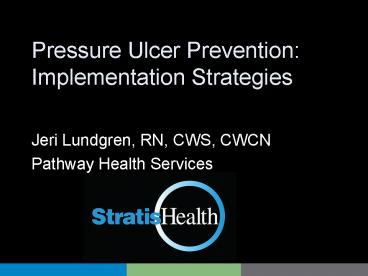Pressure Ulcer Prevention: Implementation Strategies - PowerPoint PPT Presentation
1 / 19
Title:
Pressure Ulcer Prevention: Implementation Strategies
Description:
Pressure Ulcer Prevention: Implementation Strategies. Jeri Lundgren, RN, CWS, CWCN ... The contents do not necessarily reflect CMS policy. ... – PowerPoint PPT presentation
Number of Views:3452
Avg rating:3.0/5.0
Title: Pressure Ulcer Prevention: Implementation Strategies
1
Pressure Ulcer Prevention Implementation
Strategies
- Jeri Lundgren, RN, CWS, CWCN
- Pathway Health Services
2
Prevention Program
- Prevention Program Assessment
- Include ALL staff?
- Nursing (licensed and caregivers)
- Dietary
- Therapies
- Physicians/Nurse Practitioners
3
Prevention Program
- The individual and family members
- Housekeeping, Activities, Maintenance, etc.
- Assist with answering call lights
- Monitor equipment
- Notify appropriate staff if the individual is
- in one position too long
- smells of urine or feces
- has not been given hydration, meal tray,
supplements
4
Prevention Program
- Prevention Program Assessment
- Consider the unlicensed caregivers to drive the
prevention program - Solicit feedback and ideas
- Empowerment
- Consistent assignments and universal workers
5
Assessing Programs
- Break your pressure ulcer Prevention program down
into two areas - Admission process
- On-going Prevention Program
- Utilize the Quality Improvement process when
assessing each program
6
Admission Program
- Developing a task force for skin
- Assess when and where your admissions are
happening - When and who is inspecting the skin upon
admission/within 24 hours (not just to the care
setting, but also to the unit)
7
Admission Program- cont
- Developing a task force for skin
- When and who is identifying the risk factors
within 24 hours, and - When and who is care planning/implementing the
interventions within 24 hours? - Reality -- not what the policy and procedure
states
8
Admission Process
- All care settings admission process (within the
first 24 hours) should include - A head to toe skin inspection by the licensed
staff (ideal within 8 hours) - A risk assessment for the potential for skin
breakdown - Development of a temporary plan of care
- Communication to the caregivers
9
Admission Program
- Admission Process Tips
- At a MINIMUM interventions within the first 24
hours should include - Support surfaces (bed and W/C)
- Turning repositioning schedules
- Incontinence care keeping skin clean and dry
- Heels elevated off bed
- Dietary and therapy referrals
- Access to topical dressings if admitted with
pressure ulcers
10
Prevention Program Assessment
- Does your current prevention program include
- On-going Risk Assessments per care setting
guidelines? - On-going skin inspections?
- On-going updates to the plan of care?
11
Prevention Program Assessment
- Does your current prevention program include
- On-going communication and involvement with the
direct caregivers? - How do the caregivers communicate skin concerns
(verbally or written)?
12
Prevention Program Assessment
- Does your current prevention program include
- Identified interventions/products for skin risk
factors such as - Pressure redistribution bed surface, including
access to low-air-loss and air-fluidized beds if
needed - Wheelchair cushions
- Heel lift devices and/or pillows
13
Prevention Program Assessment
- Identified interventions/products for skin risk
factors such as - Barrier ointments/creams to protect from
incontinence (are they accessible to the
caregivers) - Lifting and positioning devices
- Dietary supplements as appropriate
- A list of interventions to consider for potential
risk factors, to help develop the plan of care
14
Prevention Program Assessment
- Do you have effective communication systems
- between shifts and between caregivers (last time
turned toileted at a minimum)? - Are interventions being communicated to the
caregivers (turning schedules, heel lift,
toileting, etc.)? - Between Units?
- Between health care settings?
15
Prevention Program Assessment
- Do you have monitoring programs in place such as
- Monitoring turning and repositioning (sticky
notes) - Monitoring toileting schedules
- Assessment and confirmation that equipment is in
place and functioning properly
16
Prevention Program Assessment
- Are you utilizing your Wound Care Nurse for
prevention???? - Monitoring that the risk assessment and skin
observations are done at appropriate intervals - Monitoring that the plan of care reflects
interventions being implemented and identified
risk factors - Do the risk assessments, physician orders,
caregiver assignment sheets and MDS/RAPS match
the care plan?
17
Other Prevention Program Tips
- Do you have monitoring programs in place such as
- Monitor treatment books
- Ensure IDT is being proactive and discussing high
risk individuals (immobile, losing weight and
incontinent) - Monitor daily cares to ensure they are inspecting
the skin, doing proper peri-care, ROM,
feeding/supplements, weights, I O, etc.
18
Education
- Ongoing Education for Prevention
- During initial orientation
- At least yearly
- Include all staff
19
Stratis Health is a non-profit independent
quality improvement organization that
collaborates with providers and consumers to
improve health care.
This presentation was created by Stratis Health
under a contract with the Centers for Medicare
Medicaid Services (CMS). The contents do not
necessarily reflect CMS policy.

